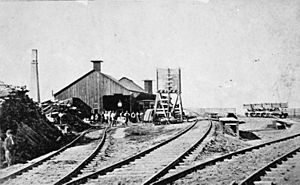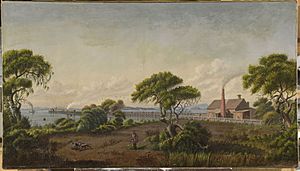Alameda Terminal facts for kids
Quick facts for kids Alameda Terminal |
|
|---|---|

Alameda Terminal, ca. 1869
|
|
| Location | Naval Air Station Alameda Alameda, California |
| Built | 1864 by the San Francisco and Alameda Railroad (1864-1870) |
| Designated | June 8, 1949 |
| Reference no. | 440 |
| Lua error in Module:Location_map at line 420: attempt to index field 'wikibase' (a nil value). | |
The Alameda Terminal (also known as the Alameda Wharf) was a very important train station and ferry dock. It was located in Alameda, on the eastern side of San Francisco Bay. From here, people could take a ferry across the bay to San Francisco.
This terminal was built in 1864 by the San Francisco and Alameda Railroad. In 1869, it became the first official western end of the First Transcontinental Railroad in the United States. This was a huge deal! The very first train from the transcontinental line arrived here on September 6, 1869. This completed the amazing journey of the railroad all the way to the Pacific coast. However, the main western stop moved to Oakland Pier just two months later.
History of the Terminal
In 1863, a lawyer named Alfred A. Cohen had a big idea. He wanted to build a railroad and a dock (wharf) in Alameda. This would allow people to travel by train and then switch to a ferry to reach San Francisco.
So, in 1864, he built a long wharf, about 3,750 feet (over 1,100 meters) into the Bay. It started near where Pacific Avenue and Main Street are today. On August 25, 1864, Cohen started passenger service. For 25 cents, people could ride a ferry called the Sophie MacLane from San Francisco to the Alameda Wharf. From there, they would take a five-mile train ride to his San Francisco and Alameda Railroad High St station.
As more people used the service, Cohen got a bigger boat called the Contra Costa. Then, in 1866, he bought his own ferry boat, named the Alameda.
The First Transcontinental Train Arrives
The Pacific Railroad Acts of 1862 allowed the building of the First transcontinental railroad and a telegraph line. Construction started in 1863, moving eastward from Sacramento on the Central Pacific Railroad line.
The plan was for the transcontinental railroad to connect with the San Francisco and San Jose Railroad (SF&SJ) in San Jose. This would allow trains to reach San Francisco. By 1866, the Western Pacific had built about 20 miles (32 km) of track from San Jose. They used about 500 Chinese workers to build the tracks through tough areas like Niles Canyon. Building stopped for a while because of problems between the builders and the money people.
In 1868, the Central Pacific Railroad took over the Western Pacific. They started building again, using up to 2,000 Chinese workers. The new plan was to connect the railroad to Oakland and its ferry service to San Francisco.
After the famous "golden spike" ceremony in Utah in May 1869, which joined the eastern and western parts of the transcontinental railroad, work continued in California. By September 1869, a temporary connection was made near San Leandro. This linked the new tracks to the old San Francisco and Alameda Railroad tracks, which led to the Alameda Wharf.
On September 6, 1869, the first Western Pacific train finally reached the shores of San Francisco Bay at Alameda Terminal. This meant the transcontinental railroad had truly reached the Pacific coast! The train left Sacramento at 10 AM and, after some delays, arrived at Alameda Terminal around 10:30 PM to a cheering crowd. Passengers then boarded the ferry Alameda to cross the Bay to San Francisco.
A special ferry called the Oakland also started service in September 1869. It was strong enough to carry up to four freight cars at a time from Alameda Wharf to San Francisco.
Just two months later, the Central Pacific Railroad moved the main western end of the transcontinental line. It moved to the much larger Oakland Pier on November 8, 1869. After this, Alameda Terminal went back to being a local train station. Freight service from Alameda continued until 1870. In 1870, the San Francisco and Alameda Railroad became part of the Central Pacific. By 1873, the original Alameda pier was no longer used.
Alameda Terminal Today
Today, the old railroads and wharves are gone from Alameda. The last train tracks were removed from Lincoln Avenue (which used to be called Railroad Avenue) in 1960.
The important moment when the first transcontinental railroad reached Alameda Terminal on September 6, 1869, is remembered with a special plaque. It's located at the Naval Air Station Alameda. There's also a California Historical Landmark (CHL #440) nearby. These markers help us remember this big part of history.
On September 6, 2019, a "golden spike" ceremony was held in Niles Canyon. This celebrated the 150th anniversary of the railroad's completion to Alameda Terminal. The mayor of Alameda also honored the many Chinese immigrants who worked incredibly hard to build the Transcontinental Railroad.



